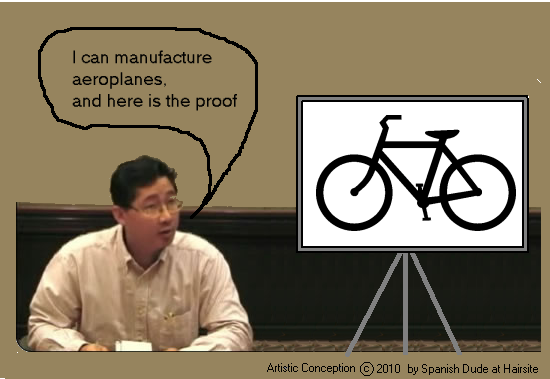Regarding the “plucked hairs” stuff (invention) …
Bioengineering the Hair Follicle
January/February/March 2007
By K. Stenn, K. Washenik, T. Barrows, S. Parimoo, Y. Zheng, and M. Boucher
Source: Bioengineering the Hair Follicle - PMC
EXTRACT:
Hair Follicle Growth from Transplantation of Follicular Fragments
Two approaches have been taken in attempting to regenerate hair follicles from follicle sections: (1) using fragments of whole follicles, or (2) using carefully dissected follicular papillae.
If new follicles could be generated efficiently by implanting a dissected, trisected or multi-sected mature anagen hair follicle, similar to the regenerative ability of the flatworm, Planaria,58 the bald patient would surely benefit. Unfortunately, although follicle regeneration from fragments of mature whole follicle is reported to occur in the human, its occurrence is irregular and inconsistent. The questions have been how many follicles can be generated from one mature follicle, how small a follicle piece can produce a complete follicle, and which follicular components are requisite for follicle regeneration. In most studies the follicle fragment to be studied is placed within the skin, or under the kidney capsule, of an immunocrippled mouse.
In work with human follicles, Kim et al., for example,59,60 showed that a complete follicle could be regenerated if one-half or two thirds of a full follicle were implanted; they reported that either lower or upper half of the donor follicle could produce a full new follicle but that implanting one-third of the follicle, upper or lower, would not work. When human hair follicles were systematically sectioned, in good numbers, and implanted into nude mouse skin, Tang et al.61 reported that in only one instance did a regenerated follicle result—this was using the upper portion of a follicle which had been transected below the sebaceous gland. Although the claim has been made that two hair follicles can be produced from one (30–70% success rates are anecdotally quoted in the hair transplantation field), the fragmented follicle approach to achieve follicle multiplication has not been critically evaluated or generally practiced.
In contrast to whole follicle fragments, studies with dissected rodent follicular papillae have shown that this structure, when implanted close to a receptive epithelium, will indeed induce a new hair follicle. Early embryonic studies of epithelial mesenchymal interactions in several animal systems suggested to developmental biologists that the rat whisker follicular papilla might be able to induce hair follicles.62 For the feather and hair follicle the important dermal component was found to be the papilla.62,63 These studies revealed that the mesenchyme (dermal tissue) dictates the site and structure of the appendage64–66) and that these signals are highly conserved between species (e.g., human-rabbit, human-rat32; human-mouse67). The power of the papilla was demonstrated in laboratory studies of truncated vibrissal follicles. These studies showed that a truncated hair follicle could reform a hair follicle if no more than the lower half of the follicle were removed;57,63,68 however, if more of the follicle were removed, regrowth could be rescued by placing a freshly dissected papilla within the truncated follicle base.69 More recent studies suggest that the papilla is, in fact, a dynamic structure which is fed by dermal sheath cells lateral to and surrounding the follicular bulb;70,71 moreover, papilla cells can also be cultured and then implanted into the upper skin to generate new follicles.71,72 A recent study using human follicle cells in humans shows that the phenomenon also applies to man.73 In the latter study a fragment of lower dermal sheath arising from a male donor was implanted into the arm skin of a female recipient with resultant new follicle formation. Marker studies indicated that the papilla cells of the new follicle expressed donor characteristics (i.e., Y chromosome). This study was provocative for two reasons: (a) it demonstrated a unique immunological privilege of the donor cells (the recent finding of the immunosuppressive molecule, CD200, expression by follicle stem cells [74] offers a plausible mechanism) and (b) properly placed human dermal cells can induce new follicle formations in living humans. Although it is generally believed that inductive mesenchyme is confined to the lower follicle connective tissue sheath, there may be weak activity in the cells of the upper follicle sheath as well.75
The above studies suggest that folliculoneogenesis requires a receptive epithelium and inductive mesenchyme. One might conclude that hair follicle engineering from dissociated cells is an opportunity whose time has come and that the process would only involve the production and placement of a population of trichogenic inductive dermal cells in close contact with a population of competent trichogenic epidermal cells in order to give the bald patient the relief he is seeking.
So it seems, the essential point has always been, where is the best point/part to “pluck” the follicle, to make 2 hairs from 1.
So already lots of researchers studied this procedure. The research paper (link above) by Aderans researchers, has been written and published in 2007.
So I wonder if Dr. Gary Hitzig has ever filed a patent for his procedure: “Auto Cloning”. Because it seems he has been the 1st who practiced this technique. All I know in this regard, is the following:
ISHRS Press Release (2003)
http://www.ishrs.org/pr-pr3.htm
http://journalreview.org/v2/articles/view/7728481.html
Dr. Jerry Cooley just mentioned in Apr 2009 that he visited Dr. Gary Hitzig in New York …
http://www.baldtruthXXXX.com/showpost.php?p=3322&postcount=8
(Replace the XXXX with “talk” within the URL!!)
… and that he has been interested in ““Hitzig’s Beard Grafting” (Auto Cloning)
Anyway, that is all I know …


